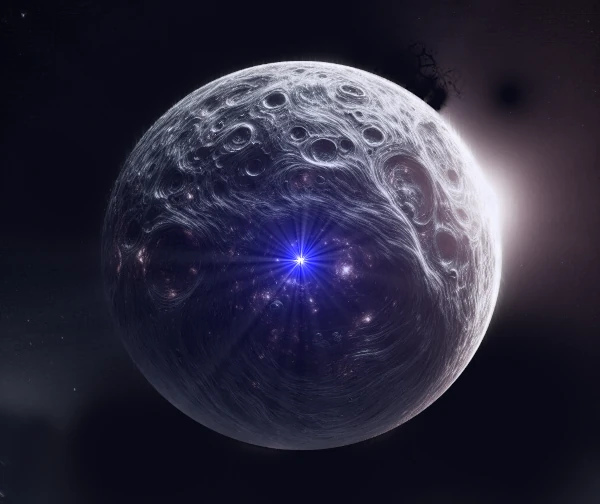
Image description: Illustration showing the influence of the Yarkovsky effect on the surface of an asteroid. Areas of solar light absorption and asymmetrical thermal re-emission are observed, creating a slight thrust due to the Yarkovsky effect. Source: Astronoo AI.
Solar energy significantly influences asteroids through the Yarkovsky Effect, which modifies their orbit and rotation. The Yarkovsky effect is a non-gravitational force due to the absorption and re-emission of solar light as heat by an asteroid.
When an asteroid is exposed to the Sun, its surface absorbs solar energy. As it rotates, it re-emits this energy as infrared radiation, which exerts a slight thrust. This thrust very slowly alters the asteroid's orbit.
The effect depends on the size, shape, rotation, and composition of the asteroid. For small asteroids (< 10 km), this effect can cause measurable orbital changes over millions of years. The Yarkovsky effect can bring them closer to or farther from the Sun, altering their trajectory and orbital stability.
The Yarkovsky effect exerts a very weak but constant force on the asteroid Apophis (370 m in diameter), whose risk of impact with Earth is not negligible. This non-gravitational force, though invisible in the short term, can cause orbital displacements over time.
Current estimates indicate that the Yarkovsky effect could induce a variation in its trajectory of several hundred kilometers over periods of several millennia. This means that, although the size of the effect may seem small compared to other gravitational forces, it becomes significant over long timescales.
Any change in Apophis's orbit due to the Yarkovsky effect contributes to more accurate predictions of potential impacts with Earth.
The YORP (Yarkovsky–O'Keefe–Radzievskii–Paddack) effect is an extension of the Yarkovsky effect, where solar radiation and thermal re-emission alter the rotation and orientation of an asteroid.
Irregularities in the asteroid's shape (craters, protrusions, etc.) cause asymmetry in heat re-emission. This asymmetry creates a torque that accelerates or decelerates the asteroid's rotation. In some cases, this can lead to disintegration if the asteroid reaches a critical rotation speed.
Small asteroids (< 10 km) are more sensitive to this effect, which can cause their rotational axis to tilt or lead to their fragmentation. This effect plays a key role in the long-term evolution of Near-Earth Asteroids (NEAs).
Sublimation of volatile materials: Asteroids containing ices (especially carbon-rich asteroids) can release gases due to solar heat. This sublimation can create jets that alter their trajectory or rotation. This is a mechanism similar to that observed in comets.
Thermal alteration: Heating/cooling cycles due to solar radiation cause thermal fractures in surface rocks. This process contributes to the disintegration of asteroids, producing debris and regolith.
Modification of asteroid populations: The Yarkovsky effect moves asteroids towards "gravitational resonances" with planets (such as Jupiter or Earth), from where they can be ejected from the solar system or directed towards Earth.
Formation of asteroid families: The YORP effect promotes the fragmentation of asteroids, contributing to the creation of asteroid families or small bodies.
Risks of impact with Earth: These effects are essential for predicting the trajectory of Earth-crossing asteroids. Ignoring these forces can lead to errors in prediction models.
Yarkovsky Effect: A variation on the order of 10-4 N (for a 1 km asteroid) can cause orbital displacements of several hundred kilometers in a million years.
YORP Effect: Changes in rotational speed are typically on the order of 10-8 rad/s/year, but can accumulate significant effects over millions of years.
Solar energy plays a major role in the dynamic evolution of asteroids. The Yarkovsky and YORP effects influence their trajectories, rotation, and even structure. These mechanisms are crucial for understanding the evolution of asteroids in the solar system and for assessing the risks of impact on Earth.